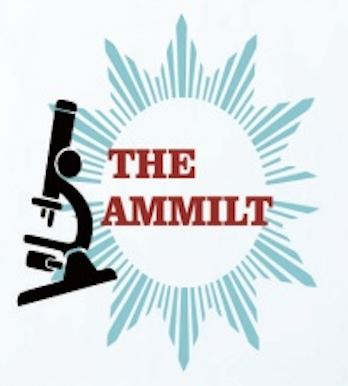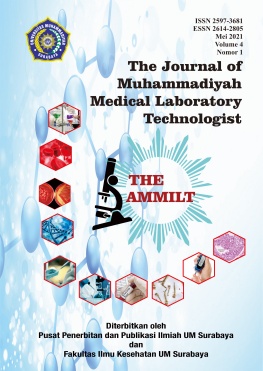Isi Artikel Utama
Abstrak
Abstract
  Tea is a beverage widely consumed by all levels of society as in addition to economic and easy to get, tea is also deemed to provide health benefits. One of the compounds that plays a role as antioxidant and antimicrobial in the tea for body health is tannin. The size of tannin content received by body depends on the way of processing tea before drinking. The higher the infusion temperature of tea infusion, it will make the content of tannin in the drinks is increasing.
  So the statement of problem in this research is whether there is any effect of infusion temperature on tannin content in tea infusion. This research aims to find out the effect of infusion temperature on tannin content in tea infusion.
  The type is experimental research. The sample is infused tea mostly consumed by people which is sold in market of Pacar Keling Surabaya. Total of samples used in this research is 40 grams of infused tea packages divided into two (2) treatments with 8 repetitions in each treatment. The variables are independent variable namely infusion temperature while the dependent variable is tannin content.
  From the examination of tannin content based on infusion temperature, it is known that the average of tannin content with infusion temperature of 700C and 1000C is 42.84% and 43.41% in a gram unit or 100 grams of infused water. The result of paired t test shows there is no effect of infusion temperature on tannin content in infusion tea with significant value more than 0.05 or 5%. Possible factor of no influence of temperature on tannin content is the length of infusion used which shall be not too long around 3-5 minutes.
Â
Password: Tea, Infusion Temperature, TanninRincian Artikel
Referensi
- DAFTAR PUSTAKA
- Adisewojo, 1982. Bercocok Tanam Teh. Sumur. Bandung.
- Agustina, Maria. 2010. 1001 Teh dari asal-usul ,tradisi, khasiat, hingga racikan teh, CV Andi Offset,Yogyakarta.
- Ajisaka, 2012. Teh Dahsyat Khasiatnya, I, Penerbit Stomata, Surabaya
- Anggraini, Dian. 2012. Pengaruh lama penyeduhan terhadap kadar tanin pada teh celup. KTI Jurusan Analis. Surabaya: FIK. UMS.
- Anggraini, Tuty. 2007. Evaluasi mutu dan waktu kadaluarsa sirup teh dari jumlah seduhan berbeda. Padang: Fakultas Pertanian. UA.
- Anonim, 1979. Daftar Komposisi Bahan Makanan Direktorat Gizi Departemen Kesehatan Republik Indonesia.Barata Karya Aksara. Jakarta.
- Arifin, 1994. Petunjuk Teknik Penglahan Teh. BPTK Gambung. Bandung.
- Browling, 1996. Pemanfaatan tannin. Pekanbaru : Pustakama Swadaya.
- Bungsu,P. 2012. Pengaruh kadar tanin pada teh celup terhadap anemia gizi besi (AGB) pada ibu hamil di UPT Puskesmas Citeureup Kabupaten Bogor. Tesis. Depok. FKM. UI.
- Cheng, G., Liu, X., and Wu, J. X. (1994) Interactive knowledge discovery through self-organizing feature maps. In Proceedings of WCNN'94, World Congress on Neural Networks, volume IV, pages 430-434. Lawrence Erlbaum, Hillsdale, NJ.
- Dyah, R.S. 2007. Peningkatan Kadar Tanin dan Penurunan Kadar Klorin sebagai upaya peningkatan nilai guna teh celup, PKMI. Malang: FIB. UMM.
- Fajriati, Imelda. Oktober 2006. Optimasi Metode Penentuan Tanin (Analisis Tanin secara Spektrofotometri dengan Pereaksi Orto Fenantrolin). Kaunia, Vol.II, No.2.http://digilib.uin-suka.ac.id. Diakses pada tanggal 5 April 2014.
- Harborne, J.B.1984.Metode Fitokimia, Edisi ke-1.ITB Bandung. http://www.scribd.comdoc/33507735/TANIN. Diakses pada tanggal 26 Juni 2014.
- Harjadi, W. 1993. Ilmu Kimia Analitik Dasar. Catatan ke 3. Gramedia. Jakarta.
- Hidayat, A. 2010, Metode Penelitian Kesehatan Paradigma Kuantitatif, Health Books Publishing, Surabaya.
- Irnawati, Hajar. 2013. Tanin (http://www.slidshare.net/HajarIrnawati/tanin.htm) Diakses pada tanggal 29 April 2014.
- Luximon-Ramma A, Neegheen VS, Bahorun T, Crozier A, Zbarsky V, Datla KP, Dexter DT, Arouma OI, 2006. Characterization of the antioxidant functions of flavonoids and proanthocyanidins in Mauritian black teas, Biofactors 27(1-4):79-91. (Abstract)
- Maria, Agustina. 2010. 1001 Teh dari asal-usul ,tradisi, khasiat, hingga racikan teh, CV Andi Offset,Yogyakarta.
- Nuraini, Indah. 2011. Klasifikasi Tanaman Teh. http://www.galeriteh.com/2011/12/klasifikasi-tanaman-teh.html. Diakses pada tanggal 15 Agustus 2014
- Nurdiansyah, S. 2009. Pemeriksaan Kadar Tanin Terhadap dau teh beverage di PT.Coca-cola Botling Indonesia, Skripsi Jurusan Kimia. Medan: FMIPA.USU.
- Pambudi, J. 2006. Potensi teh sebagai Sumber zat gizi dan perannya dalam kesehatan. Pusat Penelitian dan Pengembangan Gizi. www.pdgionline.com. Diakses pada tanggal 26 Juni 2014
- Pearson, David. 1971. The Chemical Analysis of foods. New York. Chemical publishing co.,INC.
- Peti lubis, Mutia Nugraheni. 2010. Cara tepat menyeduh teh hitam (http://life.viva.co.id/new/read/164674-cara-tepat-menyeduh-teh-hitam.htm) Diakses pada tanggal 16 Mei 2014.
- Risnasari, 2001. Pemanfaatan tanin sebagai bahan pengawet kayu. Skripsi. Medan. Universtas Sumatra Utara.
- Rohdiana, D. Sri Raharjo, dan Gardjito M, 2005. Evaluasi daya hambat tablet effervescent Teh Hijau pada oksidasi asam linoleat. Majalah Farmasi Indonesia, 16 (2), 76-80.
- Sartika, Dewi. Teh Hijau Bisa Sembuhkan Penyakit Ginjal. http://www.indomedia.com/bpost/012000/23/serba/serba4.htm diakses tanggal 10 juni 2014.
- Setyamidjaja, D. 2000. Teh, Budidaya dan Pengolahan Pasca Panen. Kanisius, Yogyakarta.
- Soehardjo, H. 1996. Teh. PT Perkebunan Nusantara. IV (PERSERO).
- Soemantri, 2011, Khasiat Teh, http://khasiatteh.com/macam-khasiat-teh-berdasar-kemasan.htm/tehseduh. diakses pada tanggal 03 Mei 2014
- Somantri ratna, K, Tanti,2011.Teh, PT.Gramedia pustaka utama anggota IKAPI, Jakarta.
- Soraya, Noni. 2007. Sehat dan Cantik berkat Teh Hijau. penebar swadaya : Jakarta.
- Spillane, J.J., 1992. Komoditi Teh Peranannya Dalam Perekonomian Indonesia. Penerbit Kanisius, Yogyakarta.
- Sugiyono. 2010. Metode Penelitian Kuantitatif, Kualitatif, dan R&D. Bandung : CV. Alfabeta.
- Sukardi. 2004. Teh Celup Penyebab Kanker.
- http://www.kompas.com/kesehatan/news/0302/12/232807.html diakses pada tanggal 20 mei 2014.
- Sumarsono. 1987. Laporan Training Tea Tester, Balai Penelitian Teh dan Kina. Gambung. Bandung.
- Tim Penulis PS, 1993. Teh, Pembudidayaan dan Pengolahan. Penebar Swadaya. Jakarta.
- Tunuwijaya, Y. 2009. Upacara minum teh, Skripsi Jurusan Biologi. Depok : FIB. UI.
- Winarno,F.G, 1981. Kimia Pangan dan Gizi. Gramedia Pustaka Utama. Jakarta.
- Yudana dan Luize, 1998. Mengenal Ragam dan Manfaat Teh http://www.indomedia.com/intisari/1998/mei/teh.htm. Diakses pada tanggal 26 Juni 2014
Referensi
DAFTAR PUSTAKA
Adisewojo, 1982. Bercocok Tanam Teh. Sumur. Bandung.
Agustina, Maria. 2010. 1001 Teh dari asal-usul ,tradisi, khasiat, hingga racikan teh, CV Andi Offset,Yogyakarta.
Ajisaka, 2012. Teh Dahsyat Khasiatnya, I, Penerbit Stomata, Surabaya
Anggraini, Dian. 2012. Pengaruh lama penyeduhan terhadap kadar tanin pada teh celup. KTI Jurusan Analis. Surabaya: FIK. UMS.
Anggraini, Tuty. 2007. Evaluasi mutu dan waktu kadaluarsa sirup teh dari jumlah seduhan berbeda. Padang: Fakultas Pertanian. UA.
Anonim, 1979. Daftar Komposisi Bahan Makanan Direktorat Gizi Departemen Kesehatan Republik Indonesia.Barata Karya Aksara. Jakarta.
Arifin, 1994. Petunjuk Teknik Penglahan Teh. BPTK Gambung. Bandung.
Browling, 1996. Pemanfaatan tannin. Pekanbaru : Pustakama Swadaya.
Bungsu,P. 2012. Pengaruh kadar tanin pada teh celup terhadap anemia gizi besi (AGB) pada ibu hamil di UPT Puskesmas Citeureup Kabupaten Bogor. Tesis. Depok. FKM. UI.
Cheng, G., Liu, X., and Wu, J. X. (1994) Interactive knowledge discovery through self-organizing feature maps. In Proceedings of WCNN'94, World Congress on Neural Networks, volume IV, pages 430-434. Lawrence Erlbaum, Hillsdale, NJ.
Dyah, R.S. 2007. Peningkatan Kadar Tanin dan Penurunan Kadar Klorin sebagai upaya peningkatan nilai guna teh celup, PKMI. Malang: FIB. UMM.
Fajriati, Imelda. Oktober 2006. Optimasi Metode Penentuan Tanin (Analisis Tanin secara Spektrofotometri dengan Pereaksi Orto Fenantrolin). Kaunia, Vol.II, No.2.http://digilib.uin-suka.ac.id. Diakses pada tanggal 5 April 2014.
Harborne, J.B.1984.Metode Fitokimia, Edisi ke-1.ITB Bandung. http://www.scribd.comdoc/33507735/TANIN. Diakses pada tanggal 26 Juni 2014.
Harjadi, W. 1993. Ilmu Kimia Analitik Dasar. Catatan ke 3. Gramedia. Jakarta.
Hidayat, A. 2010, Metode Penelitian Kesehatan Paradigma Kuantitatif, Health Books Publishing, Surabaya.
Irnawati, Hajar. 2013. Tanin (http://www.slidshare.net/HajarIrnawati/tanin.htm) Diakses pada tanggal 29 April 2014.
Luximon-Ramma A, Neegheen VS, Bahorun T, Crozier A, Zbarsky V, Datla KP, Dexter DT, Arouma OI, 2006. Characterization of the antioxidant functions of flavonoids and proanthocyanidins in Mauritian black teas, Biofactors 27(1-4):79-91. (Abstract)
Maria, Agustina. 2010. 1001 Teh dari asal-usul ,tradisi, khasiat, hingga racikan teh, CV Andi Offset,Yogyakarta.
Nuraini, Indah. 2011. Klasifikasi Tanaman Teh. http://www.galeriteh.com/2011/12/klasifikasi-tanaman-teh.html. Diakses pada tanggal 15 Agustus 2014
Nurdiansyah, S. 2009. Pemeriksaan Kadar Tanin Terhadap dau teh beverage di PT.Coca-cola Botling Indonesia, Skripsi Jurusan Kimia. Medan: FMIPA.USU.
Pambudi, J. 2006. Potensi teh sebagai Sumber zat gizi dan perannya dalam kesehatan. Pusat Penelitian dan Pengembangan Gizi. www.pdgionline.com. Diakses pada tanggal 26 Juni 2014
Pearson, David. 1971. The Chemical Analysis of foods. New York. Chemical publishing co.,INC.
Peti lubis, Mutia Nugraheni. 2010. Cara tepat menyeduh teh hitam (http://life.viva.co.id/new/read/164674-cara-tepat-menyeduh-teh-hitam.htm) Diakses pada tanggal 16 Mei 2014.
Risnasari, 2001. Pemanfaatan tanin sebagai bahan pengawet kayu. Skripsi. Medan. Universtas Sumatra Utara.
Rohdiana, D. Sri Raharjo, dan Gardjito M, 2005. Evaluasi daya hambat tablet effervescent Teh Hijau pada oksidasi asam linoleat. Majalah Farmasi Indonesia, 16 (2), 76-80.
Sartika, Dewi. Teh Hijau Bisa Sembuhkan Penyakit Ginjal. http://www.indomedia.com/bpost/012000/23/serba/serba4.htm diakses tanggal 10 juni 2014.
Setyamidjaja, D. 2000. Teh, Budidaya dan Pengolahan Pasca Panen. Kanisius, Yogyakarta.
Soehardjo, H. 1996. Teh. PT Perkebunan Nusantara. IV (PERSERO).
Soemantri, 2011, Khasiat Teh, http://khasiatteh.com/macam-khasiat-teh-berdasar-kemasan.htm/tehseduh. diakses pada tanggal 03 Mei 2014
Somantri ratna, K, Tanti,2011.Teh, PT.Gramedia pustaka utama anggota IKAPI, Jakarta.
Soraya, Noni. 2007. Sehat dan Cantik berkat Teh Hijau. penebar swadaya : Jakarta.
Spillane, J.J., 1992. Komoditi Teh Peranannya Dalam Perekonomian Indonesia. Penerbit Kanisius, Yogyakarta.
Sugiyono. 2010. Metode Penelitian Kuantitatif, Kualitatif, dan R&D. Bandung : CV. Alfabeta.
Sukardi. 2004. Teh Celup Penyebab Kanker.
http://www.kompas.com/kesehatan/news/0302/12/232807.html diakses pada tanggal 20 mei 2014.
Sumarsono. 1987. Laporan Training Tea Tester, Balai Penelitian Teh dan Kina. Gambung. Bandung.
Tim Penulis PS, 1993. Teh, Pembudidayaan dan Pengolahan. Penebar Swadaya. Jakarta.
Tunuwijaya, Y. 2009. Upacara minum teh, Skripsi Jurusan Biologi. Depok : FIB. UI.
Winarno,F.G, 1981. Kimia Pangan dan Gizi. Gramedia Pustaka Utama. Jakarta.
Yudana dan Luize, 1998. Mengenal Ragam dan Manfaat Teh http://www.indomedia.com/intisari/1998/mei/teh.htm. Diakses pada tanggal 26 Juni 2014

